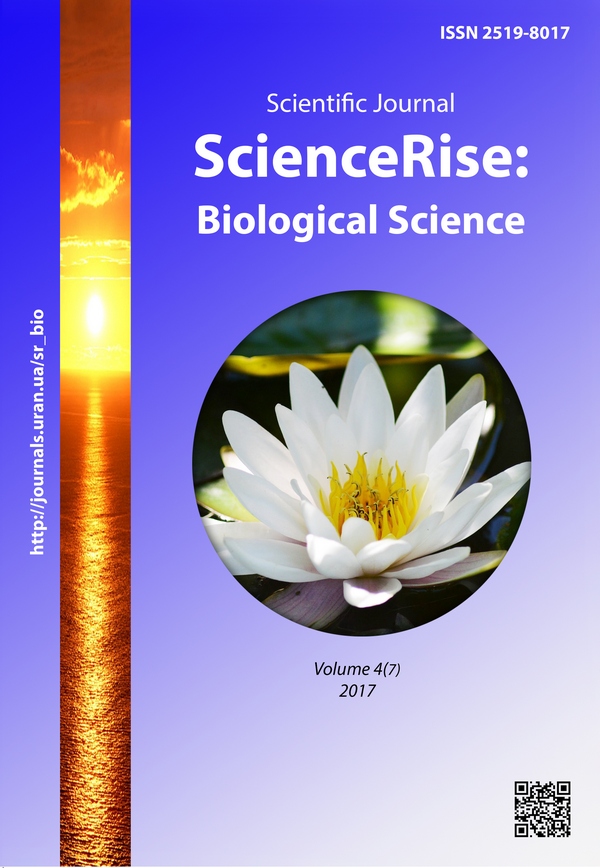Вплив світлодіодного випромінювання різних довжин хвиль на інтенсивність росту Staphylococcus Aureus
DOI:
https://doi.org/10.15587/2519-8025.2017.109244Ключові слова:
світлодіодне випромінювання, Staphylococcus aureus, вплив, ріст, фотомодифікація, гнійно-запальні захворювання, фототерапіяАнотація
Наведені результати досліджень впливу світлодіодного випромінювання червоно-інфрачервоного та синьо-інфрачервоного діапазонів на ріст клінічних ізолятів Staphylococcus aureus та колекційного тест-штаму Staphylococcus aureus ATCC 25923. Встановлено, що ефект впливу випромінювання залежить від його довжини хвилі, експозиції та частоти. Розроблено методичні рекомендації використання світлодіодного випромінювання у комплексній терапії гнійно-запальних процесів стафілококової етіології
Посилання
- Salmanov, A. G. (2015). Antimіkrobna rezistentnіst ta іnfektsіi, asotsіyovanі z medychnoyu dopomohoyu v Ukraiinі. Epіdemіologіchnіy zvіt multіtsentrovogo doslіdzhennya (2010–2014) [Antimicrobial resistance and infections associated with medical care in Ukraine. Epidemiological Report multicenter study (2010–2014)]. Kyiv: Agrar Media Group, 452.
- Oliynyk, О. V., Кrasiy, N. І. (2013). Analysis of the antibiotics resistance in the patients, treated in the Ternopyl university hospital. Klinichna khirurhiia, 10, 52–55.
- Tong, S. Y. C., Davis, J. S., Eichenberger, E., Holland, T. L., Fowler, V. G. (2015). Staphylococcus aureus Infections: Epidemiology, Pathophysiology, Clinical Manifestations, and Management. Clinical Microbiology Reviews, 28 (3), 603–661. doi: 10.1128/cmr.00134-14
- Voronkina, I. A., Derkach, S. A., Krilova, I. A., Gabysheva, L. S. (2015). Experimental study of biofilm-forming ability to Methicillin resistant and Meticillin-susceptible Staphylococcus aureus. Annals of Mechnikov Institute, 4, 59–65.
- Pirog, T. P., Nikituk, L. V., Makienko, V. O., Shevchuk, T. A., Iutynska G. O. (2017). Regulation of antimicrobial activity of surfactants, synthesized by Nocardia Vaccinii IMV B-7405. Mikrobiolohichnyi Zhurnal, 3, 27–35.
- Wang, H. H., Schaffner, D. W. (2011). Antibiotic Resistance: How Much Do We Know and Where Do We Go from Here? Applied and Environmental Microbiology, 77 (20), 7093–7095. doi: 10.1128/aem.06565-11
- Tor, Y., Fair, R. (2014). Antibiotics and Bacterial Resistance in the 21st Century. Perspectives in Medicinal Chemistry, 6, 25–64. doi: 10.4137/pmc.s14459
- Demain, A. L. (2014). Importance of microbial natural products and the need to revitalize their discovery. Journal of Industrial Microbiology & Biotechnology, 41 (2), 185–201. doi: 10.1007/s10295-013-1325-z
- Cortes-Sanchez, A. de J., Hernandez-Sanchez, H., Jaramillo-Flores, M. E. (2013). Biological activity of glycolipids produced by microorganisms: New trends and possible therapeutic alternatives. Microbiological Research, 168 (1), 22–32. doi: 10.1016/j.micres.2012.07.002
- Slivka, M., Korol, N., Pantyo, V., Baumer, V., Lendel, V. (2017). Regio- and stereoselective synthesis of [1,3]thiazolo[3,2-b][1,2,4]triazol-7-ium salts via electrophilic heterocyclization of 3-S-propargylthio-4Н-1,2,4-triazoles and their antimicrobial activity. Heterocyclic Communications, 23 (2), 109–113. doi: 10.1515/hc-2016-0233
- Babii, O., Afonin, S., Berditsch, M., Reiber, S., Mykhailiuk, P. K., Kubyshkin, V. S. et. al. (2014). Controlling Biological Activity with Light: Diarylethene-Containing Cyclic Peptidomimetics. Angewandte Chemie International Edition, 53 (13), 3392–3395. doi: 10.1002/anie.201310019
- Faraone, V., Denaro, L., Ruello, E., Scarmato, A., Vermiglio, G., Ruggeri, P. (2008). Phototreatment of radiation-induced dermal injuries. Acta Medica Mediterranea, 24 (2), 99–104.
- Gulyar, S. A., Kosakovskyi, A. L. (2011). Bioptron-PILER-light application in medicine. Kyiv: IFB NAN Ukrainy NMAPO MZ Ukrainy, 256.
- Popov, V. D. (2011). Sovremennye aspekty lasernoi terapii [Modern aspects of laser therapy]. Cherkassy: Vertikal, 608.
- Gulyar, S. A. (Ed.) (2009). Anthology of light therapy. Medical BIOPTRON technologies (Theory, clinical application, prospects). Kyiv: Izd-vo In-ta fiziol. im. A.A. Bogomol'tsa NAN Ukrainy, 1024.
- Gulyar, S. A. (2015). Medolayt: osnovy likuval'noyi diyi svitlodiodnoyi tekhniky. Kyiv: IMITs, 64.
- Brill, G. E. (2007). Some methodological aspects of the study of low-power laser radiation biological effects. Photobiology and photomedicine, 5 (1), 5–13.
- Pantyo, V. V., Koval, G. M., Pantyo, V. I. (2016). The influence of low intensity laser radiation on sensitivity to antibiotics of Pseudomonas aeruginosa. ScienceRise: Biological Science, 2 (2), 18–24. doi: 10.15587/2519-8025.2016.77688
- Pantyo, V. V., Nikolaychuk, V. I., Pantyo, V. I. (2009). Influence of low-intensive laser radiation on biological objects (examination of literature). Scientific Bulletin of the Uzhgorod University. Series: Biology, 26, 99–106.
- Gulyar, S. A., Ukrainskaya, E. A., Lesik, G. I., Tolochina, O. F., Chalenko, Yu. V. (2009). Poly- and monochromatic light influence on microorganisms growth in hard nutrient mediums and its clinical significance at periodontitis. Anthology of light therapy. Medical BIOPTRON technologies. Kyiv: Izd-vo In-ta fiziol. im. A. A. Bogomol'tsa NAN Ukrainy, 802–824.
##submission.downloads##
Опубліковано
Як цитувати
Номер
Розділ
Ліцензія
Авторське право (c) 2017 Valery Pantyo, Galina Koval, Valery Pantyo, Sergiy Gulyar

Ця робота ліцензується відповідно до Creative Commons Attribution 4.0 International License.
Наше видання використовує положення про авторські права Creative Commons CC BY для журналів відкритого доступу.
Автори, які публікуються у цьому журналі, погоджуються з наступними умовами:
1. Автори залишають за собою право на авторство своєї роботи та передають журналу право першої публікації цієї роботи на умовах ліцензії Creative Commons CC BY, котра дозволяє іншим особам вільно розповсюджувати опубліковану роботу з обов'язковим посиланням на авторів оригінальної роботи та першу публікацію роботи у цьому журналі.
2. Автори мають право укладати самостійні додаткові угоди щодо неексклюзивного розповсюдження роботи у тому вигляді, в якому вона була опублікована цим журналом (наприклад, розміщувати роботу в електронному сховищі установи або публікувати у складі монографії), за умови збереження посилання на першу публікацію роботи у цьому журналі.










